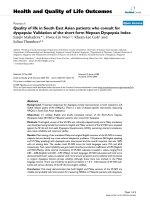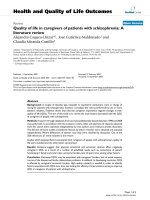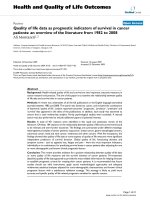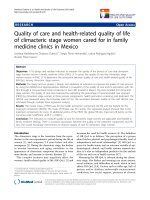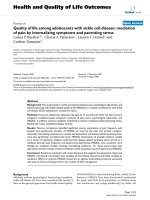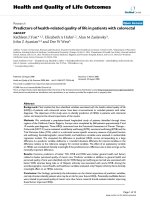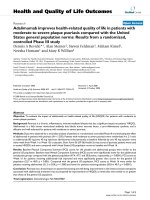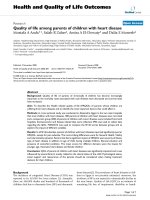báo cáo hóa học:" Quality of life in patients with psoriasis" pptx
Bạn đang xem bản rút gọn của tài liệu. Xem và tải ngay bản đầy đủ của tài liệu tại đây (288.41 KB, 7 trang )
BioMed Central
Page 1 of 7
(page number not for citation purposes)
Health and Quality of Life Outcomes
Open Access
Review
Quality of life in patients with psoriasis
Monali J Bhosle
1
, Amit Kulkarni
1
, Steven R Feldman
2
and
Rajesh Balkrishnan*
1
Address:
1
Ohio State University College of Pharmacy and School of Public Health, 500 W. 12th Avenue, Columbus, OH 43210, USA and
2
Center
for Dermatology Research, Department of Dermatology, Wake Forest University School of Medicine, Medical Center Boulevard, Winston-Salem,
North Carolina, 27157-1071, USA
Email: Monali J Bhosle - ; Amit Kulkarni - ; Steven R Feldman - ;
Rajesh Balkrishnan* -
* Corresponding author
Abstract
Psoriasis is one of the prevalent skin conditions in the United States. This chronic condition has a
significant negative impact on patients' quality of life. Psoriasis has been linked to the depression
and suicidal tendencies in the patients. The costs associated with decrements in quality of life, lost
productivity, and work absenteeism may be enormous, increasing overall costs associated with the
disease management. This review attempts to outline different quality of life measures available for
psoriasis and describes their use in studies examining patient reported outcomes associated with
pharmacological interventions for psoriasis. Factors associated with quality of life in psoriasis
patients are described. It further describes physician's role in the psoriasis management to improve
patients' overall well-being.
Review
Psoriasis: a growing problem
Psoriasis affects approximately 2% of the world's popula-
tion, with men and women being equally affected [1]. In
the United States (US) about 250,000 new cases of psoria-
sis are observed annually, affecting almost 2.2% of the US
population [2,3]. Psoriasis accounted for nearly 2.25 mil-
lion visits to ambulatory care centers during 1996 in the
US [4].
Psoriasis is a serious condition strongly affecting the way
a person sees himself and the way he is seen by others. It
has tremendous economic and financial ramifications.
Total annual cost for treating psoriasis is estimated to be
in the range of $1.6 billion to $4.3 billion dollars [5-7].
Psoriasis is linked with social stigmatization, pain, dis-
comfort, physical disability and psychological distress [8].
Impact of psoriasis on patients' quality of life
Psoriasis has a significant negative impact on patients'
health related quality of life (HRQoL). In a survey by the
National Psoriasis Foundation almost 75% of patients
believed that psoriasis had moderate to large negative
impact on their quality of life (QoL), with alterations in
their daily activities [9]. Another study reported that at
least 20% of psoriasis patients had contemplated suicide
[10]. Furthermore, physical and emotional effects of pso-
riasis were found to have a significant negative impact at
patients' workplace as measured by the validated scales
including Work Productivity Assessment Index (WPAI),
SF-8, Hospital Anxiety and Depression (HADS) and past
medical/psoriasis history [11]. Absenteeism is a greater
concern for people suffering from psoriasis than their co-
workers without psoriasis with nearly 60% patients
reporting missing an average of 26 days a year directly
Published: 06 June 2006
Health and Quality of Life Outcomes 2006, 4:35 doi:10.1186/1477-7525-4-35
Received: 07 April 2006
Accepted: 06 June 2006
This article is available from: />© 2006 Bhosle et al; licensee BioMed Central Ltd.
This is an Open Access article distributed under the terms of the Creative Commons Attribution License ( />),
which permits unrestricted use, distribution, and reproduction in any medium, provided the original work is properly cited.
Health and Quality of Life Outcomes 2006, 4:35 />Page 2 of 7
(page number not for citation purposes)
related to their psoriasis [12]. Patients with psoriasis have
a higher financial burden due to absenteeism in addition
to the cost of caring for their disease [13,14].
Psoriasis patients often experience difficulties like mala-
daptive coping responses, problems in body image, self
esteem, self concept and also have feelings of stigma,
shame and embarrassment regarding their appearance
[8]. This is often times accompanied by a perception of
being evaluated by others based on their disfigurement
[8]. Individuals with psoriasis commonly engage in cop-
ing strategies to avoid unwanted and unpleasant social
consequences. However, most of these strategies fail to
improve patients' QoL [14-16]. Discussing their skin con-
dition, covering their lesions, and avoiding contact with
people are significantly associated with negative impact
on life [11-16]. Studies have indicated that talking to oth-
ers regarding the non-contagious nature of psoriasis less-
ens the negative impact on the QoL and thereby reduces
social discomfort [17].
Studies that have probed the link between psoriasis and
depression hint towards a reciprocal relation between
them. Psoriasis patients were more likely to be depressed
than the general population with patients' age, education
and disease severity being important predictors of psycho-
logical distress in the patient cohort [18,19]. Gupta et al.
in their study of 127 psoriasis patients found that 9.7% of
patients reported their wish to be dead, and 5.5% reported
active suicidal ideation at the time of the study [20]. These
studies have highlighted the need for psychosocial strate-
gies in treating patients with psoriasis and helping them
to improve their overall QoL.
Determinants of QoL in psoriasis patients
Various factors may be attributed to the lower QoL in pso-
riasis patients. The chronic and recurring nature of this
disease often brings about a feeling of hopelessness in
terms of cure for the condition [21]. Patients are con-
stantly concerned with the interference with future plans
due to an unexpected outbreak of symptoms. This possi-
bly intensifies due to their lack of control over the disease
[21]. Lack of control is one of the most bothersome
aspects in psoriasis patients [22].
Many psoriasis patients experience social and psychologi-
cal difficulties created by their environment [23]. Psoriasis
patients may feel humiliated when they need to expose
their bodies during swimming, intimate relationships,
using public showers, or living in conditions that do not
provide appropriate privacy [24]. Many of the patients
suffering from psoriasis often feel the need to hide their
disease, thus severely affecting their self confidence [25].
People suffering from psoriasis feel that the general public
and sometimes their own physicians fail to appreciate the
negative impact of psoraisis on their life [10,15]. Psoriasis
has an immense impact on social life, with patients fre-
quently complaining of social difficulties and friction
with family members [26]. Psoriasis patients frequently
feel ashamed and embarrassed about their condition and
considered this to be the worst aspect of their disease [27].
High levels of stress in this population may often result
from other people reacting to their disease or anticipation
of the same [27].
Psoriasis is also associated with limitations in daily activ-
ities, occupational, and sexual functioning [14,28,29].
Patients with psoriasis suffer comparable disability as
other patients with chronic illnesses [16]. All these factors
may have detrimental effect on the patients' QoL [30]. In
one qualitative study carried out to assess the determi-
nants of QoL in the US population with psoriasis, body
surface area showed the strongest association with decre-
ments in QoL (Spearman's ρ = 0.50; p < 0.0001), among
other factors including patients' age, gender, income,
duration of psoriasis, and number of physicians seen in
last two years. Increasing psoriasis severity was signifi-
cantly associated with seeking care from multiple physi-
cians and having decrements in income in this population
[31]. While measures of body surface area affected by pso-
riasis are commonly used in clinical trials to assess severity
of the disease, there is a movement which argues that QoL
standard would be a better method of determining the
severity of psoriasis [10]. In the clinic setting, treatment
judgments may be largely guided by QoL issues.
Tools to measure QoL
Various measures have been used to assess QoL in psoria-
sis patients. These measures may be categorized as psoria-
sis-specific, skin specific, generic QoL measures, and
"mixed" measures. Following section attempts to describe
each of these categories with related examples. Psoriasis
specific measures are the most sensitive, however the
more general measures facilitate comparisons across dis-
eases. Often, studies measuring QoL in psoriasis patients
utilize more than one of the available measures men-
tioned here. Use of these measures varied across different
clinical controlled trials examining effect of different
pharmacological treatments on QoL of psoriasis patients
(Table 1).
Psoriasis-specific measures
Psoriasis Index of Quality of Life (PSORIQoL)
The PSORIQoL is based on a "needs-based" approach.
This instrument is based on the theory that "life gains its
quality from the ability and capacity of individuals to sat-
isfy their needs" [30]. This 25 dichotomous item instru-
ment was developed through interviews conducted in
Health and Quality of Life Outcomes 2006, 4:35 />Page 3 of 7
(page number not for citation purposes)
Table 1: Table Quality of Life Measures and Outcomes in Randomized Controlled Trials for Psoriasis Treatments
Study Title (Year) Treatment QoL Measures Outcomes
"Impact of efalizumab on patient-
reported outcomes in high-need
psoriasis patients: results of the
international, randomized,
placebo-controlled Phase III
Clinical Experience Acquired with
Raptiva (CLEAR) trial" (2005) 40
Efalizumab 1 mg/kg/wk (n = 529)
or placebo (n = 264) for 12 weeks
1. SF-36
2. DLQI
3. PSA
4. VAS for itching
5. PGPA
QOL, measured using all QOL
measures, was significantly higher
among the Efalizumab group as
compared with the placebo group
(p < 0.001)
"Patient-reported outcomes of
psoriasis improvement with
etanercept therapy: results of a
randomized phase III trial" (2005)
[41]
Etanercept 50 mg twice weekly (n
= 194) Placebo (n = 193),
etanercept 50 mg per week (n =
196) during the initial 12-week,
double-blind period.
1.DLQI
2.SF-36
3. PGPA
DLQI total score improved by 65–
70% in etanercept group
compared with 6% in placebo
group (P < 0.0001). Significant
improvement in etanercept group
as measured by other SF-36 and
PGPA
"Alefacept in the treatment of
psoriasis in patients for whom
conventional therapies are
inadequate" (2005) [42]
Alefacept (Amevive
®
)1. PASI
2. DLQI
The QOL effects of alefacept in
patients who were not candidates
for conventional systemic psoriasis
therapies or phototherapy were
similar to those reported
previously for the overall
alefacept-treated population in the
phase III studies (p = 0.001).
"Infliximab treatment results in
significant improvement in the
quality of life of patients with
severe psoriasis: a double-blind
placebo-controlled trial" (2005)
[43]
Intravenous infusions of 3 or 5 mg
kg(-1) of infliximab or placebo
DLQI Infliximab induction therapy
resulted in a substantial
improvement in HRQOL. At week
10, patients in the infliximab 3- and
5-mg kg(-1) groups showed a
median percentage improvement
in DLQI scores of 84.0% and
91.0%, respectively, compared
with 0% in the placebo group (P <
0.001)
"The efficacy and tolerability of
clobetasol propionate foam 0.05%
in the treatment of mild to
moderate plaque-type psoriasis of
nonscalp regions" (2003) [44]
Clobetasol propionate foam
(clobetasol foam) 0.05%
PGA Clobestasol propionate foam
0.05% had greater improvement in
QoL as compared to other topical
therapies reported by patients.
"Quality of life and clinical
outcome in psoriasis patients using
intermittent cyclosporine" (2001)
[45]
Cyclosporin (Neoral
®
) (n = 255) 1. DLQI
2. PASI
Intermittent short courses of
cyclosporin significantly improved
the QoL of the patients and
decreases the extent and severity
of disease and itch
"The impact of a two-compound
product containing calcipotriol and
betamethasone dipropionate
(Daivobet/Dovobet) on the quality
of life in patients with psoriasis
vulgaris: a randomized controlled
trial" (2004) [46]
Combination therapy with topical
vitamin D analogue calcipotriol (50
microg g(-1)) and corticosteroid
betamethasone dipropionate (0.5
mg g(-1)) vs. calcipotriol
monotherapy
1. PDI
2. EuroQoL 5D
3. VAS
Once-daily application of the
combination product was found to
be superior to calcipotriol twice
daily terms of QoL
"The effect of treatment on quality
of life in psoriasis patients" (2005)
[47]
Treatment with short contact
dithranol treatment, UVB
phototherapy or inpatient
dithranol
1. Dutch short form of the SIP
2. PDI
Comparable improvement in
HRQoL with short contact
dithranol treatment and UVB
phototherapy, inpatients
experienced a more impaired
HRQoL and showed no significant
improvement in HRQoL directly
following treatment
"Methotrexate versus cyclosporine
in moderate-to-severe chronic
plaque psoriasis" (2003) [48]
Methotrexate (n= 44; initial dose,
15 mg per week) or cyclosporine
(n= 44; initial dose, 3 mg per
kilogram of body weight per day)
1. PASI
2. PGA
The difference in the QOL for
both the treatment arms was
statistically insignificant
Health and Quality of Life Outcomes 2006, 4:35 />Page 4 of 7
(page number not for citation purposes)
three countries in Europe. An American version has also
been recently developed. It has the advantage of being
based on theory and measuring the impact of the disease
on QoL rather than assessing impairment or disability.
Moreover, it is expected to work in a uniform manner
across patient samples, irrespective of age and gender
[30].
Psoriasis Life Stress Inventory (PLSI)
The PLSI is a 15-item questionnaire that provides a meas-
ure of the daily hassles of psychosocial stress associated
with having to cope with everyday events in living with
psoriasis. Scores on this scale range from 0 to 45. The PLSI
also permits patients to be classified as a function of their
distribution of scores into two groups: those patients who
react significantly to the stress associated with having pso-
riasis (score of > 10); and those patients who are not sig-
nificantly affected with having psoriasis-related stress
(score of < 10). The PLSI is scored by having the respond-
ent rate the absolute frequency with which each item has
been experienced in the last 4 weeks from (scoring 0) to a
great deal (scoring 3) [27].
Psoriasis Disability Index (PDI)
The PDI is a 15-item scale that specifically addresses self-
reported disability in areas of daily activities, employ-
ment, personal relationships, leisure and treatment
effects. The items are concerned with the practical effects
of psoriasis in every day life [27].
Psoriasis Area and Severity Index (PASI) and Simplified PASI (SAPASI)
Four main areas were assessed for calculation of the PASI
scores: the head, the trunk, the upper extremities, and the
lower extremities, corresponding to 10%,20%,30%, and
40% of the total body area, respectively. The maximum
score for PASI is 72. The SAPASI is a self-assessed, using
the same criteria as the PASI, but presented in non-profes-
sional terminology. Scores on the SAPASI range from 0 to
72 [25]. Though in essence the PASI and the SAPASI are
measures for severity of psoriasis, they provide an ade-
quate picture of the impact of the disease on patients'
QoL. Studies have indicated an inverse relationship
between QoL and severity of psoriasis. Moreover, PASI is
the most widely used measure of severity in the research
as well as the clinical setting. This makes it an important
tool in gauging the impact of the disease on QoL, though
other instruments to measure QoL are encouraged. Since
PASI or SAPASI do not measure the impact of psoriasis on
patients' QoL directly, use of other QoL scales is recom-
mended.
Skin-specific measures
Questionnaire on Experience with Skin Complaints (QES)
The short form of the QES with 23 items is a valid instru-
ment for examination of social and psychic burdens of
psoriasis. The recording of stigmatization feeling and of
quality of life determines different supplementary aspects
of the illness-related stress of patients with chronic skin
diseases [32].
Dermatology Life Quality Index (DLQI)
The DLQI is a compact self-reported questionnaire to
measure HRQoL over the previous week in patients with
skin diseases. It consists of 10 items covering symptoms
and feelings (items 1 and 2), daily activities (items 3 and
4), leisure (items 5 and 6), work and school (item 7), per-
sonal relationships (items 8 and 9) and treatment (item
10). Each item is scored on a four point scale, with higher
scores indicating greater impairment in HRQoL [33].
Generic QOL measures
Short Form 36 (SF-36)
The SF-36 health survey is a widely used generic, 36-item,
self-reported health status questionnaire assessing 8
domains of health status(1) physical activities;(2) social
activities;(3) usual physical role activities;(4) bodily
pain;(5) general mental health (6) usual emotional role
activities; (7) vitality ;(8)general health perceptions. A
score from 0 to 100 is calculated for each subscale, with
higher scores indicating better HRQL [25]. The SF-36 may
be the best characterized measure for comparing QoL dif-
ferences across different diseases. The SF-36 was used to
show that the impact of psoriasis is as great as that of other
major medical disorders [16].
Subjective Well Being Scale (SWLS)
The SWLS is a short 5-item instrument designed to meas-
ure global life satisfaction. The scale has been validated
and correlates with other measures of subjective well-
being (SWB). The SWLS was developed to assess satisfac-
"Calcipotriol vs. tazarotene as
combination therapy with
narrowband ultraviolet B (311
nm): efficacy in patients with
severe psoriasis" (2000) [49]
Combination of UVB (311 nm) and
tazarotene vs. UVB (311 nm) plus
calcipotriol or vice versa
PASI No significant differences in QoL
of patients in both the regimens
"A comparison of treatment with
dithranol and calcipotriol on the
clinical severity and quality of life in
patients with psoriasis" (1998) [50]
Calcipotriol ointment (50
micrograms/g) twice daily or
Dithrocream (short-contact
dithranol) 0.1–2%
1. PDI
2. SIP
Significant improvement in
patients' QoL as assessed by the
PDI and the SIP were seen in both
treatment groups, with greater
improvement in calcipotriol group
Table 1: Table Quality of Life Measures and Outcomes in Randomized Controlled Trials for Psoriasis Treatments (Continued)
Health and Quality of Life Outcomes 2006, 4:35 />Page 5 of 7
(page number not for citation purposes)
tion with the respondent's life as a whole, without assess-
ing satisfaction with specific life event [25].
EuroQoL 5D (EQ-5D)
The EQ-5D is a standardized generic instrument devel-
oped for describing and valuing health states. The EQ-5D
was created for use in population health surveys or in con-
junction with a condition-targeted instrument for assess-
ment of outcomes related to specific health conditions or
their treatment. It specifically refers to health status at the
time of questioning. The first of 2 parts records a patient's
health state along 5 dimensions (mobility, self-care, usual
activities, pain/discomfort, and anxiety/depression). Each
dimension has 3 levels reflecting no problem, some prob-
lem, and extreme problem. Respondents are asked to indi-
cate one of the 3 levels along each of the 5 dimensions.
This classifies respondents into 1 of 243 distinct health
states. The second part of the EQ-5D is a 20-cm VAS that
has the end points: "best imaginable health state" (100)
and "worst imaginable health state"(0). Respondents are
asked to illustrate how they rate their own health stat by
drawing a line to that best represents their own health
state on that day [25].
Mixed QoL measures
Salford Psoriasis Index (SPI)
The SPI is derived from combining a score of current
severity of psoriasis based on the PASI, a score indicating
psychosocial disability, and a score based on historical
information. The resultant three- figure SPI (signs, psy-
chosocial disability, interventions) is a similar paradigm
to the TNM (tumor, nodes, metastasis) classification used
for cancer staging [34].
Koo-Menter Psoriasis Instrument (KMPI)
The Koo-Menter Psoriasis Instrument (KMPI) is a diag-
nostic algorithm and a formal measure, to aid in identify-
ing patients with significant impact on QoL warranting
systemic therapy. In addition, the KMPI can be used to
document and justify treatment decisions for health care
payers. While the decision to undertake systemic treat-
ment and the choice of specific treatment plan must ulti-
mately be made mutually by the patient and the
physician, these tools are designed to provide information
that will be valuable in making informed decisions
regarding treatments [35].
Pharmacological treatments and their impact on QoL
Topical corticosteroids remain the mainstay of psoriasis
therapy in the US. Steroid potencies range from class 7
steroids, such as 1% hydrocortisone, which is available in
drug- without prescription, to superpotent class 1 corti-
costeroids such as clobestasol propionate, halobetasol
propionate, betamethasone dipropionate [36]. The side
effects of topical potent corticosteroids limit their use to
an extent, and they are prescribed less frequently outside
the US.
Primary treatments for severe psoriasis are phototherapy,
systemic retinoids, methotrexate, cyclosporine and newer
biological therapies. Ultraviolet B (UVB) phototherapy is
an effective treatment for psoriasis and has been the safest
way to maintain control of extensive psoriasis over the
long-term. If UVB phototherapy is not sufficient to con-
trol a patient's psoriasis, then a combination of UVB plus
the oral retinoid acitretin is often effective. These therapies
often result in prolonged remission of varying duration;
however, they are inconvenient for the patient. Advances
in our understanding of the immune system in psoriasis
have seen the development of biological agents which tar-
get molecular and cellular events leading to the disease.
Alefacept was approved by the FDA for the treatment of
psoriasis in January 2003. It inhibits the activation of T
cells and reduces the number of activated memory T cells
through apoptosis. As it causes reduction in activated
memory T cells, T cells counts are performed to monitor
for toxicity. Etanercept which antagonizes Tumor Necrosis
Factor (TNF) activity was approved by the FDA in 2002.
Studies using infliximab, an anti-TNF anti-body, also have
shown efficacy in the treatment of psoriasis. TNF inhibi-
tors are not FDA- approved for psoriasis, however, they
are approved for other indications and physicians can pre-
scribe them for psoriasis. Adalimumab is also other TNF
inhibitor [37].
Different pharmacological treatments available for psoria-
sis are found to have varying effects on patients' QoL.
Table 1 illustrates outcomes reported in various rand-
omized controlled trials examining the effect of pharma-
cological intervention on patients QoL. Few studies have
reported head to head comparisons of effect of different
psoriasis treatments in improving QoL. More recently,
studies are focused on understanding the effect of biologic
agents on patients QoL, however none of them reported
direct comparison of these agents. Clinical trials most
often used DLQI or PDI to measure QoL. While very few
trials utilized single QoL instrument, others used multiple
instruments for QoL measurement. Although the exact
reason for utilizing more than one measure for QOL was
not mentioned in these studies, this may potentially be
done to either compare measures or because no single
measure was considered to be superior over the other with
each offering a different aspect to the measure of QoL.
Physicians' role: what we need to know
Counseling patients with psoriasis may improve their
mental and psychological condition. Such treatment
should be aimed at increasing personal control, encourag-
ing active coping strategies, restructuring negative
thoughts about the disease, and encouraging patients to
Health and Quality of Life Outcomes 2006, 4:35 />Page 6 of 7
(page number not for citation purposes)
express emotions, seek social support and distract them-
selves [36]. Inducing remission and achieving reduction
in severity of psoriasis (reduce area affected by psoriasis)
may not be enough. Pharmacologic interventions should
be accompanied by patient education and reassurance by
family and social interventions [21].
As in treatment of other medical conditions, establishing
a strong physician-patient relationship is the foundation
of effective psoriasis treatment. Due to the recurring
nature of the disease, patients are not only frustrated with
the disease, but also with the care they receive or have
received in the past. Physicians have to be empathetic and
work with the patient to effectively manage their disease.
Establishing this bond and trust between patient and phy-
sician will encourage patients to be more complaint to
their physician's recommendations concerning treatment
and will potentially improve treatment compliance and
outcomes [38,39].
The physician may find many opportunities during the
patient interview to establish this bond. To start, the phy-
sician should sit within touching distance of the patient
and palpate the lesions as a part of physical examination.
This act helps the patient overcome inhibitions regarding
social interactions. Touching communicates that the
patient is not untouchable and that the psoriasis does not
have to impede intimate social relationships. Physicians
should also ask a few leading questions about how psoria-
sis influences the patient's life. This communicates a sense
of empathy and understanding that will assure the patient
of the physician's competence in managing psoriasis.
Conclusion
Psoriasis is a serious condition and is associated with sig-
nificantly lower QoL. Studies have utilized different meas-
ures available to assess QoL of psoriasis patients. Most
commonly used measures were psoriasis specific such as
PASI and DLQI followed by generic measures such as SF-
36. Pharmacological interventions along with patient
counseling and education may be an effective strategy to
improve QoL among psoriasis patients. Lack of head to
head comparisons of available treatment options limits
conclusions regarding superiority of one agent over
another in improving QoL in psoriasis patients.
Competing interests
The Center for Dermatology Research is supported by an
unrestricted educational grant from Galderma Laborato-
ries. Dr. Feldman has received research, speaking and/or
consulting support from Abbott, Amgen, Biogenidec,
Centocor, Connetics, Genentech, and Roche.
Authors' contributions
Ms. Bhosle and Mr. Kulkarni were responsible for the lit-
erature review and writing of the manuscript. Dr. Feldman
and Dr. Balkrishnan critically revised the manuscript.
References
1. Raychaudhuri SP, Farber EM: The prevalence of psoriasis in the
world. J Eur Acad Dermatol Venereol 2001, 15:16-17.
2. Lebwohl M: Psoriasis. Lancet 2003, 361:1197-1204.
3. Stern RS, Nijsten T, Feldman SR, Margolis DJ, Rolstad T: Psoriasis is
common, carries a substantial burden even when not exten-
sive, and is associated with widespread treatment dissatis-
faction. J Investig Dermatol Symp Proc 2004, 9:136-9.
4. Linden KG, Weinstein GD: Psoriasis: current perspectives with
an emphasis on treatment. Am J Med 1999, 107:595-605.
5. Lewin Group: The Burden of Skin Diseases 2005. The Society for
Investigative Dermatology and the American Academy of Dermatology
Association 2005 [ />].
6. Khachemoune A, Phillips TJ: Current treatment options in pso-
riasis. Hosp Pract 2000, 35:93-96.
7. Javitz HS, Ward MM, Farber E, Nail L, Vallow SG: The direct cost
of care for psoriasis and psoriatic arthritis in the United
States. J Am Acad Dermatol 2002, 46:850-860.
8. Fortune DG, Richards HL, Griffiths CE: Psychologic factors in
psoriasis: consequences, mechanisms, and interventions.
Dermatol Clin 2005, 23:681-694.
9. National Psoriasis Foundation Benchmark Survey [http://
www.psoriasis.org/files/pdfs/press/npfsurvey.pdf]. accessed April 3,
2006
10. Krueger G, Koo J, Lebwohl M, Menter A, Stern RS, Rolstad T: The
impact of psoriasis on quality of life: results of a 1998
National Psoriasis Foundation patient-membership survey.
Arch Dermatol 2001, 137:280-284.
11. Pearce DJ, Singh S, Balkrishnan R, Kulkarni A, Fleischer AB, Feldman
SR: The negative impact of psoriasis on the workplace. J Der-
matolog Treat 2006, 17:24-28.
12. de Arruda LH, De Moraes AP: The impact of psoriasis on quality
of life. Br J Dermatol 2001, 144:33-36.
13. Feldman SR, Fleischer AB Jr, Reboussin DM, Rapp SR, Bradham DD,
Exum ML, Clark AR: The economic impact of psoriasis
increases with psoriasis severity. J Am Acad Dermatol 1997,
37:564-569.
14. Finlay AY, Coles EC: The effect of severe psoriasis on the qual-
ity of life of 369 patients. Br J Dermatol 1995, 132:236-244.
15. Choi J, Koo JY: Quality of life issues in psoriasis. J Am Acad Der-
matol 2003, 49:S57-S61.
16. Rapp SR, Feldman SR, Exum ML, Fleischer AB Jr, Reboussin DM: Pso-
riasis causes as much disability as other major medical dis-
eases. J Am Acad Dermatol 1999, 41:401-407.
17. Rapp SR, Cottrell CA, Leary MR: Social coping strategies associ-
ated with quality of life decrements among psoriasis
patients. Br J Dermatol 2001, 145:610-616.
18. Devrimci-Ozguven H, Kundakci TN, Kumbasar H, Boyvat A: The
depression, anxiety, life satisfaction and affective expression
levels in psoriasis patients. J Eur Acad Dermatol Venereol 2000,
14:267-271.
19. Esposito M, Saraceno R, Giunta A, Maccarone M, Chimenti S: An
Italian study on psoriasis and depression. Dermatology 2006,
212:123-127.
20. Gupta MA, Schork NJ, Gupta AK, Kirkby S, Ellis CN: Suicidal idea-
tion in psoriasis. Int J Dermatol 1993, 32:188-190.
21. Vardy D, Besser A, Amir M, Gesthalter B, Biton A, Buskila D: Expe-
riences of stigmatization play a role in mediating the impact
of disease severity on quality of life in psoriasis patients. Br J
Dermatol 2002, 147:736-742.
22. Rapp SR, Feldman Sr, Fleischer AB Jr, Reboussin DM, Exum ML:
Health related quality of life in psoriasis: A biopsychosocial
model and measures. In Care Management of Skin Diseases Life
Quality and Economic Impact Edited by: Rajagopalan R, Sherertz EF,
Anderson R. New York, New York:Marcel Dekker, Inc;
1998:125-145.
23. Seng KT, Nee ST: Group therapy: a useful and supportive
treatment for psoriasis patients. Int J Dermatol 1997,
36:110-112.
Publish with BioMed Central and every
scientist can read your work free of charge
"BioMed Central will be the most significant development for
disseminating the results of biomedical researc h in our lifetime."
Sir Paul Nurse, Cancer Research UK
Your research papers will be:
available free of charge to the entire biomedical community
peer reviewed and published immediately upon acceptance
cited in PubMed and archived on PubMed Central
yours — you keep the copyright
Submit your manuscript here:
/>BioMedcentral
Health and Quality of Life Outcomes 2006, 4:35 />Page 7 of 7
(page number not for citation purposes)
24. Ginsburg IH, Link BG: Psychosocial consequences of rejection
and stigma feelings in psoriasis patients. Int J Dermatol 1993,
32:587-591.
25. Weiss SC, Kimball AB, Liewehr DJ, Blauvelt A, Turner ML, Emanuel
EJ: Quantifying the harmful effects of psoriasis on health-
related quality of life. J Am Acad Dermatol 2002, 4:512-518.
26. Jowett S, Ryan T: Skin disease and handicap: an analysis of the
impact of skin conditions. Soc Sci Med 1985, 20:425-429.
27. Fortune DG, Main CJ, O'Sullivan TM, Griffiths CE: Quality of life in
patients with psoriasis: the contribution of clinical variables
and psoriasis-specific stress. Br J Dermatol 1997, 137:755-760.
28. Gupta MA, Gupta AK: Psoriasis and sex: a study of moderately
to severely affected patients. Int J Dermatol 1997, 36:259-262.
29. Wahl AK, Gjengedal E, Hanestad BR: The bodily suffering of living
with severe psoriasis: in -depth interviews with 22 hospital-
ized patients with psoriasis patients. Qual Health Res 2002,
12:250-261.
30. McKenna SP, Cook SA, Whalley D, Doward LC, Richards HL, Grif-
fiths CE, Van Assche D: Development of the PSORIQoL, a pso-
riasis-specific measure of quality of life designed for use in
clinical practice and trials. Br J Dermatol 2003, 149:323-331.
31. Gelfand JM, Feldman SR, Stern RS, Thomas J, Rolstad T, Margolis DJ:
Determinants of quality of life in patients with psoriasis: a
study from the US population. J Am Acad Dermatol 2004,
51:704-708.
32. Schmid-Ott G, Burchard R, Niederauer HH, Lamprecht F, Kunsebeck
HW: Stigmatization and quality of life of patients with psoria-
sis and atopic dermatitis. Hautarzt 2003, 54:852-857.
33. Mazzotti E, Barbaranelli C, Picardi A, Abeni D, Pasquini P: Psycho-
metric properties of the Dermatology Life Quality Index
(DLQI) in 900 Italian patients with psoriasis. Acta Derm Vener-
eol 2005, 85:409-413.
34. Kirby B, Fortune DG, Bhushan M, Chalmers RJ, Griffiths CE: The Sal-
ford Psoriasis Index: an holistic measure of Psoriasis sever-
ity. Br J Dermatol 2000, 142:728-732.
35. Feldman SR, Koo JY, Menter A, Bagel J: Decision points for the ini-
tiation of systemic treatment for psoriasis. J Am Acad Dermatol
2005, 53:101-107.
36. Lebwohl M: Future psoriasis therapy. Dermatol Clin 1995,
13:915-923.
37. Feldman SR, Garton R, Averett W, Balkrishnan R, Vallee J: Strategy
to manage the treatment of severe psoriasis: considerations
of efficacy, safety and cost. Expert Opin Pharmacother 2003,
4:1525-1533.
38. Renzi C, Tabolli S, Picardi A, Abeni D, Puddu P, Braga M: Effects of
patient satisfaction with care on health-related quality of life:
a prospective study. J Eur Acad Dermatol Venereol 2005,
19:712-718.
39. Renzi C, Picardi A, Abeni D, Agostini E, Baliva G, Pasquini P, Puddu P,
Braga M: Association of dissatisfaction with care and psychiat-
ric morbidity with poor treatment compliance. Arch Dermatol
2002, 138:337-342.
40. Ortonne JP, Shear N, Shumack S, Henninger E: Impact of efalizu-
mab on patient-reported outcomes in high-need psoriasis
patients: results of the international, randomized, placebo-
controlled Phase III Clinical Experience Acquired with Rap-
tiva (CLEAR) trial. BMC Dermatol 2005, 5:13.
41. Krueger GG, Langley RG, Finlay AY, Griffiths CE, Woolley JM, Lalla
D, Jahreis A: Patient-reported outcomes of psoriasis improve-
ment with etanercept therapy: results of a randomized
phase III trial. Br J Dermatol 2005, 153:1192-1199.
42. van de Kerkhof P, Griffiths CE, Christophers E, Lebwohl M, Krueger
GG: Alefacept in the treatment of psoriasis in patients for
whom conventional therapies are inadequate. Dermatology
2005, 211:256-263.
43. Feldman SR, Gordon KB, Bala M, Evans R, Li S, Dooley LT, Guzzo C,
Patel K, Menter A, Gottlieb AB: Infliximab treatment results in
significant improvement in the quality of life of patients with
severe psoriasis: a double-blind placebo-controlled trial. Br J
Dermatol 2005, 152:954-960.
44. Gottlieb AB, Ford RO, Spellman MC: The efficacy and tolerability
of clobetasol propionate foam 0.05% in the treatment of
mild to moderate plaque-type psoriasis of nonscalp regions.
J Cutan Med Surg 2003, 7:185-192.
45. Salek MS, Finlay AY, Lewis JJ, Sumner MI: Quality of life and clinical
outcome in psoriasis patients using intermittent
cyclosporine (Neoral). Qual Life Res 2004, 13:91-95.
46. van de Kerkhof PC: The impact of a two-compound product
containing calcipotriol and betamethasone dipropionate
(Daivobet/Dovobet) on the quality of life in patients with
psoriasis vulgaris: a randomized controlled trial. Br J Dermatol
2004, 151:663-668.
47. Prins M, Krabbe PF, Swinkels QO, de Boo T, vande Kerkhof PC, van
der Valk PG: The effect of treatment on quality of life in pso-
riasis patients. Acta Derm Venereol 2005, 85:304-310.
48. Heydendael VM, Spuls PI, Opmeer BC, de Borgie CA, Reitsma JB,
Goldschmidt WF, Bossuyt PM, Bos JD, de Rie MA: Methotrexate
versus cyclosporine in moderate-to-severe chronic plaque
psoriasis. N Engl J Med 2003, 349:658-665.
49. Schiener R, Behrens-Williams SC, Pillekamp H, Kaskel P, Peter RU,
Kerscher M: Calcipotriol vs. tazarotene as combination ther-
apy with narrowband ultraviolet B (311 nm): efficacy in
patients with severe psoriasis. Br J Dermatol 2000, 143:1275-8.
50. Wall AR, Poyner TF, Menday AP: A comparison of treatment
with dithranol and calcipotriol on the clinical severity and
quality of life in patients with psoriasis. Br J Dermatol 1998,
139:1005-1011.
